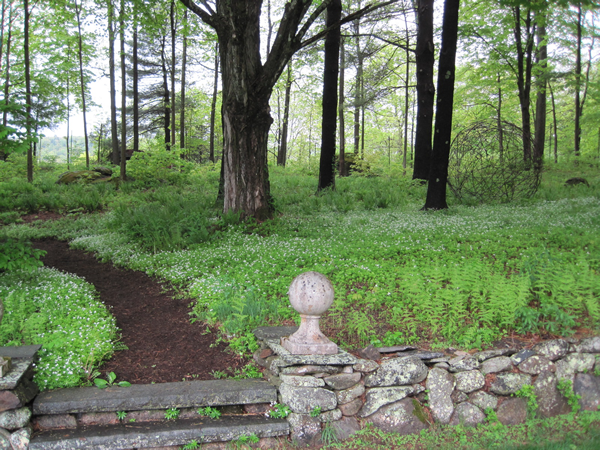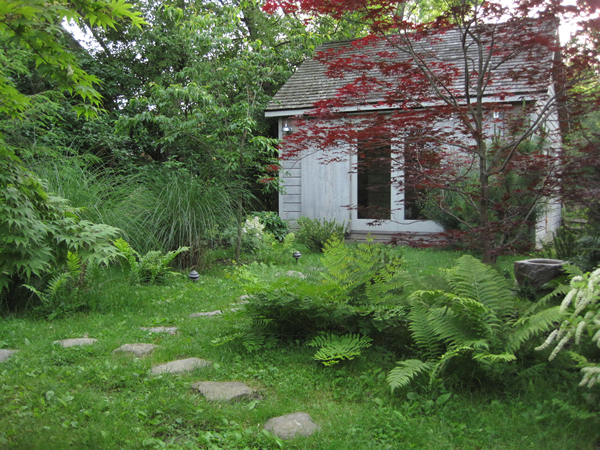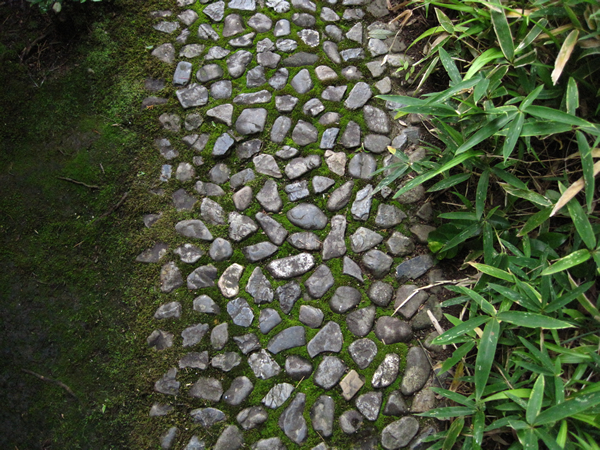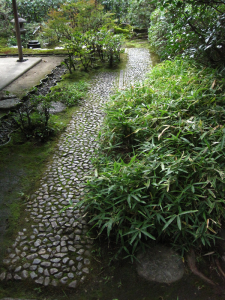Stones are priceless in Japan. I”ve seen gardens created in the 16th century that have stones and rocks imported from far away that are worth their weight in gold. Seriously. It”s part of the statement of a lord or king”s garden – or in Japan”s case – the Shogun”s garden. Just look at Versailles if you can”t travel to the east. It”s the same mentality.
I shy away from that sort of thing and rely on what is near at hand with only a suggestion of intent – not of wealth and power – but of a turning inward and coming back to a sense of self amidst the ordinary.
However, I can”t help but be in awe of this place:

When Okubo Tadazane, lord of Odawara (present-day Kanagawa Prefecture) sent thousands of fist-sized rounded beach stones to Emperor Kokaku for his garden in 1815, each one came wrapped individually in silk cloth.
The garden should look wonderful in all seasons of the year. The evergreens at this time are the focal point: the round Boxwood balls, the floppy leaves of the Hemlock and the graceful structure of the Japanese Pines stand out in the spare winter landscape.
It’s at this time that we notice the fences, wicket gate and bones of hedges. Space, structure and pattern are now evident – hidden at other times of the year.




Blithwood is the ultimate romantic, hidden garden on the banks of the Hudson River with views of the Catskill Mountains beyond. The Italianate garden is walled on three sides with a small reflecting pool in the center.
 The garden sits below a turn-of-the-century mansion overlooking the Hudson River. The land dates back to a vast track bought from the Indians in 1680. The grounds began their metamorphosis from untamed woods into a carefully landscaped estate in the 1830s, when Robert Donaldson of North Carolina acquired the property and gave it the name Blithewood. He commissioned Andrew Jackson Downing, one of the foremost landscape artists of the day, to design the grounds.
The garden sits below a turn-of-the-century mansion overlooking the Hudson River. The land dates back to a vast track bought from the Indians in 1680. The grounds began their metamorphosis from untamed woods into a carefully landscaped estate in the 1830s, when Robert Donaldson of North Carolina acquired the property and gave it the name Blithewood. He commissioned Andrew Jackson Downing, one of the foremost landscape artists of the day, to design the grounds.
I first came upon this house in the mid 70’s when, like many other estates along the Hudson, it was abandoned. I have an old photo of the main door with OM painted across it.
Since then it’s come into the possession of Bard College which has restored the house and sunken garden below it. Climbing vines, roses, pergola covered with wisteria, boxwood and grasses create a place of tranquil beauty.


I study gardens. Every summer I sign up for the Garden Conservancy Open House tours. This year I went over to Connecticut, about an hour away to suss out Bunny Williams garden. It’s awesome. She has lots of land and many gardeners so she’s been able to make a woodland garden that almost defies belief. The best part was the beginning as you enter. Off in the distance, catching the corner of your eye is something not ‘animal or vegetable’. Brilliant. Wish I had the space for it.

I covet that rusted wire orb

I first learned to garden when I lived at Green Gulch Zen Center in California. Green Gulch is a working organic farm that grows vegetables and flowers for market. I learned about Biodynamic farming, watched gardeners plant seeds in rows of dark rich earth, walked by steaming hot compost piles and weeded in the flower gardens.
Zen is known for its close relationship with the arts, in particular gardening, poetry, calligraphy and the tea ceremony. As part of my Zen practice I have been studying the Way of Tea for many years. This study includes flower arranging, garden design, architecture, literature, the connoisseurship of the fine and applied arts and cuisine. Kaiseki cuisine is a seven course meal served during a tea gathering and in 1997 I wrote a book about it called The World in a Bowl of Tea.
When I moved to my home in Tivoli, New York I continued my Tea and Zen practice and built a small tea house in my back yard. One important element in any Tea gathering is the garden and the path to the tea house, called a Roji. To learn more about this I went to Japan to study Japanese garden design at Kyoto University of Art and Design.
It was my first trip to Japan and I felt completely at home. At last I could walk through the gardens I had heard so much about. I wandered through ancient temples and drank in the atmosphere of the timeless spaces.
This is the story of how I built a Tea house in my backyard and how I created the gardens that surround it. I incorporate many of the ideas of the wild garden, the English cottage garden, the prairie garden all the while working within the rustic, elegant style of the Tea Ceremony.
excerpt – A Tea Garden in Tivoli

The key element of the Roji is the path that crosses boundaries and entrances and guides you to the tea house. Stone paths are traditional and the stones in the outer path are straight with a formal pattern, the stones in the inner path are scattered, yet purposeful. They guide you through the space and slow you down, involve you and take you out of yourself. There is a sense of bridging, crossing over and proceeding deeper into the Roji leaving the dust of the world behind.

-excerpt from A Tea Garden in Tivoli



















